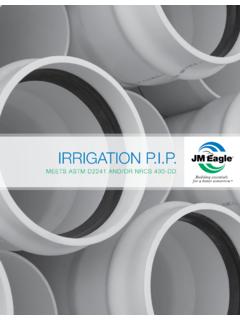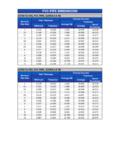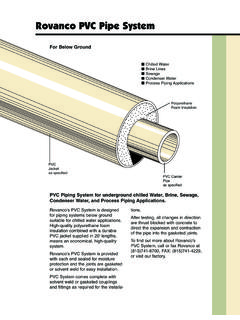Transcription of APPENDIX C - UNIT PIPE PRICES C.1 Introduction …
1 C-1 APPENDIX C - unit pipe Introduction and SummaryThis APPENDIX summarizes unit pipe PRICES and their derivation. The cost of constructingpipelines is the largest single cost in the project, accounting for $65 million of the total project cost aspresented in Table 7-1 (Volume I). Project costs are sensitive to the unit PRICES of pipe . Tables C-1aand C-1b summarize the selected unit pipe PRICES in October 1998 values. Table C-2 comparesselected unit pipe PRICES with Bureau of Reclamation estimates for this project. Comparison with bidprices received by the State in the project region in August 2000 is also presented. The methodology of arriving at unit pipe PRICES involved examination of bidding on projects inSouth Dakota, namely the Mni Wiconi and Mid-Dakota Projects. The chief difference betweenprojects building in South Dakota and projects in Montana, however, is the difference in prevailingwage rates in the two states. It will be shown that prevailing wage rates in South Dakota for laborclassifications used in a rural water project of the type proposed for Fort Peck and Dry Prairie are half(or less than half) of the prevailing wage rates in shown in Tables C-1a and C-1b, different unit PRICES were derived for the Fort Peck IndianReservation and Dry Prairie.
2 Experience in South Dakota demonstrates that contractors are bidding athigher rates on the Indian reservations than outside them. Part of the price difference is due to wagerate differences on South Dakota reservations as contrasted with the rest of the State, part is due toremoteness of the reservations, part is due to preference provisions in construction contracts and part isdue to lack of competition between a smaller set of contractors bidding on the reservations than oncomparable projects outside the reservations. Contractor perceptions of risk related to disputeresolution and tribal courts and perceptions regarding the availability of qualified labor force may alsocontribute to higher PRICES . While many of the reasons for differences in unit pipe PRICES on and off theSouth Dakota Indian reservations may be dissipated with experiences of contractors on the largeprojects underway in that State, the historic differences have been applied here to insure conservatism.
3 In actual practice, the Fort Peck Tribes have been strong advocates of the proposed project, the majorproject components are to be built along Highway 2 with access to rail for material deliveries, andthe cooperation among sponsors in the project area has been a positive factor. The tribal council hastaken steps throughout project planning to insure the integrity of the project for its membership and hasalso taken steps to accommodate Dry Prairie and federal and state guidance as necessary for projectimplementation. There may be little if any actual difference in pipe PRICES between Fort Peck and DryPrairie in the course of this C-1aWEIGHTED unit pipe PRICE BY DIAMETERFORT PECK INDIAN RESERVATIONT otal Costs Per FootAWWAAWWAAWWAAWWAAWWAASTMASTMASTMC-90 5C-905C-905C-900C-900D2241D2241D2241DR 41DR 25DR 18DR 18DR 14 SDR 26 SDR 21 SDR 17 Nominal100 165 235 150 200 160 200 250 ------------------2 3 4 6 8 10 12 ----------14 16 18 20 24 TABLE C-1bWEIGHTED unit pipe PRICE BY DIAMETERDRY PRAIRIET otal Costs Per FootAWWAAWWAAWWAAWWAAWWAASTMASTMASTMC-90 5C-905C-905C-900C-900D2241D2241D2241DR 41DR 25DR 18DR 18DR 14 SDR 26 SDR 21 SDR 17 Nominal100 165 235 150 200 160 200 250 2 3 4 6 8 10 12 ----------14 In order to reflect the difference between Montana and South
4 Dakota prevailing wage rates, it wasnecessary to separate unit pipe PRICES into basic components. Those components included material PRICES ,equipment costs for excavating or trenching, labor costs for installing pipe and operating excavation equipmentand overhead and profit. These basic costs were derived for pipe diameters ranging from 2 inches to 24 inchesand for pressure classes ranging from 150 to 350 pounds per square inch (psi). Specifications for ASTM,AWWA and welded steel or ductile iron were considered. Following a trial division of pipe PRICES into itsC-3 NominalAverageDiameter"Little"(in) ASRWSDPRWSASRWSDPRWSFort Peck2$ $ $ $ $ RecommendedTABLE C-2 COMPARISON OF unit pipe PRICESFROM DIFFERENT SOURCES components, each pipe cost was calibrated to experience in South Dakota on-Reservation and off-Reservation. Part of the calibration process involved application of prevailing wage rates to basic assumptions on labor andproductivity. Assumptions were also made with respect to reductions in material, equipment, and overhead andprofit rates to match the experience in South Dakota.
5 Following calibration to South Dakota pipe PRICES , allassumptions respecting material PRICES , equipment costs and overhead and profit were maintained, and Montanawage rates were applied to arrive at Montana unit pipe pipe sizes were derived through a process of optimization designed to minimize the presentvalue of pipeline and pumping station construction, operation, maintenance and replacement costs. Themethodology is described further in Chapter addition to the selected PRICES presented in Table C-1a and C-1b, Bureau of Reclamation estimatesfor this project are presented for comparison in Table C-2. Bureau of Reclamation derived estimates based, inpart, on experience from bid PRICES received in communities in the project region. In general, selected pricesand Bureau of Reclamation estimates are in reasonably close agreement. Reclamation unit PRICES are generallyless than selected unit pipe PRICES presented in Table C-1 for all Dry Prairie pipe PRICES . Reclamation unit pricesare higher than Fort Peck Indian Reservation PRICES for 18 inch through 24 inch diameters and lower for allsmaller Bureau of Reclamation, April 2000, Construction Cost Trends, < >2< >, Brent Crude, August 31, Basin Inter-Agency Committee, December 1971, Missouri River Basin ComprehensiveFramework Study, Hydrologic Analyses, Volume 6, p.
6 9, et PRICES for the little Fort Peck Rural Water Project (near Fort Peck Dam, not the Fort PeckAssiniboine and Sioux Rural Water System) received by the State of Montana in August 2000 were alsoreviewed as presented in Table C-2. PRICES were adjusted downward to reflect October 1998 PRICES based oncost trends1 and to reflect a deduction available from the low bidder for award of two bid schedules. After theadjustment, PRICES bid were significantly higher for the smaller diameters than either the selected unit PRICES orBureau of Reclamation estimates. pipe bid was generally class 160 and class 200, comparable to the pipeclasses that reflect the selected PRICES . The State bid PRICES were noticeably higher than the selected unit pricesfor the Assiniboine and Sioux Rural Water System for diameter classes 2 through 4 inches but less for largerdiameters. State bid PRICES were noticeably higher than the selected unit PRICES for Dry Prairie in all diametersthrough 10 inch.
7 The State bid PRICES , however, were for two small schedules with combined pipe value of$931,000. Moreover, crude oil PRICES reached $ per barrel at the end of August 2000, as compared with$ to $ per barrel in the third quarter 19982, and PVC pipe (manufactured from petroleum-basedresin) was in short supply and high demand. Cost indices only reflected a 6% difference between periods andare too imprecise to properly reflect differences in unit pipe PRICES . The State bid PRICES were not consideredrepresentative of PRICES to be received by the Assiniboine and Sioux or Dry Prairie Rural Water Systems.(Those not seeking to review the detailed cost derivations following this summary may advance tosection Considerable detail was provided in the following subsections of APPENDIX C for the reason that(1) pipe costs are the highest major cost item and (2) experience from South Dakota is not only extensive butdiscloses differences in pricing factors that must be considered here).
8 Dakota Bidding Experience: through 12 Inches in DiameterTable C-3 summarizes actual bid PRICES received for 1 through 12 inch PVC pipe by the Oglala SiouxRural Water Supply System (OSRWSS) in South Dakota from FY 1993 through FY 1998. As discussedabove, these PRICES were considered relevant to the cost estimating for the Project because they represent thegreatest number of bid openings on an Indian Reservation in the Northern Great Plains, and the PRICES reflectlabor rates that can be adjusted for the current Project. The names and dates of the bid openings are providedin Table conditions are reasonably comparable. OSRWSS is constructed on soils derived from theunderlying Pierre shale, comparable to the Fort Union formation underlining northeastern Montana. Weatherconditions are not radically different as they relate to construction. The mean frost free period is 120 days in theOSRWSS area and nearly the same in northeastern Montana. Precipitation averages 16 inches annually inOSRWSS and between 12 and 14 inches in northeastern Montana3, perhaps contributing to more wetland inOSRWSS, but that effect is offset in northeastern Montana by presence of glacial potholes and the abandoned C-5 TABLE C-3 ACTUAL OGLALA SIOUX RWSS LOW BID pipe PRICES ($/lineal feet)
9 SOUTH DAKOTAP roject and Bid Date ---------------------------------------- ---------------------------------------- ---------- White Kyle Slim Kyle to Kyle to West Mand Mand Mand Mand Clay North Buttes Sharps 1 Sharps 2 Boundary I II III IVDiameter/Class 7/13/93 6/ 1/94 6/ 1/94 10/ 1/94 10/ 1/94 3/22/95 5/30/96 5/30/96 5/21/97 8/13/98--------------------------------- ---------------------------------------- --------------------------------- 12 CL200/C900 CL200/D2241 CL160/D2241 10 CL200/C900 CL150/C900 CL200/D2241 CL160/D2241 8 CL250/D2241 CL200/D2241
10 CL160/D2241 6 CL200/C900 CL250/D2241 CL200/D2241 CL160/D2241 4 CL250/D2241 CL200/D2241 CL160/D2241 3 CL250/D2241 CL200/D2241 CL160/D2241 2 CL250/D2241








